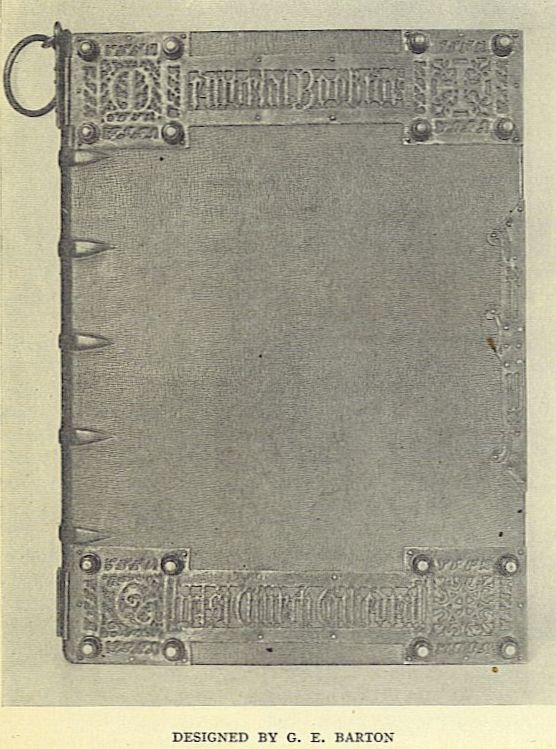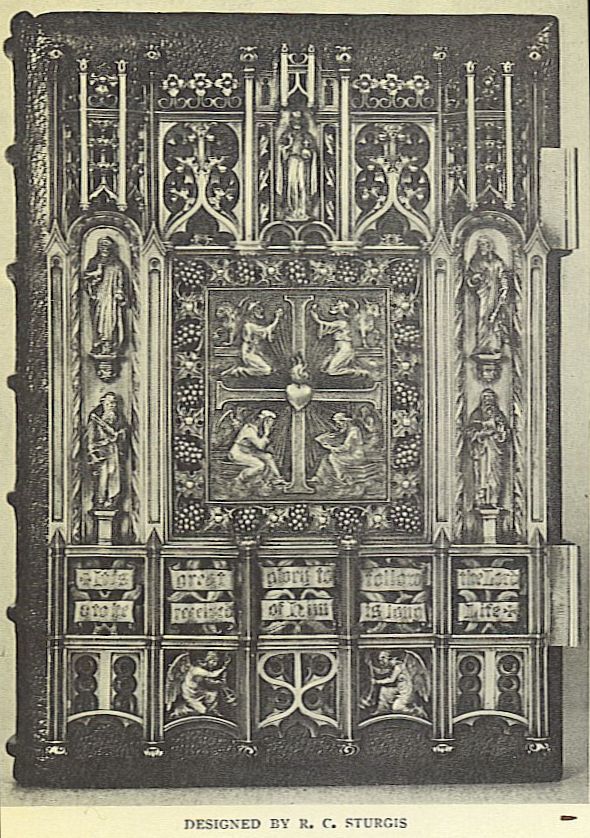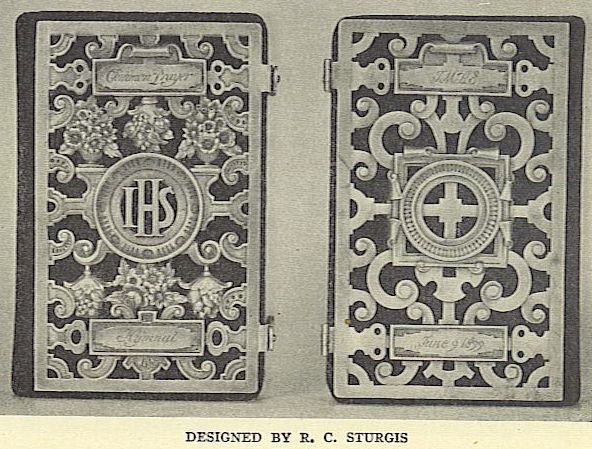SOME SUMPTUOUS BOOK-BINDINGS
CARRIED OUT AT THE
MERRYMOUNT PRESS, BOSTON.
BY NATHAN HASKELL DOLE.
THE BREAKING of the “alabaster box of ointment, very precious,” and Christ’s rebuke to those who condemned the extravagance will always serve for a sufficient justification to the conscientious for any amount of money spent in the decoration of all adornment of churches and the beautification of all that pertains to religious service. Art need never fear reprehension from her foster sister, Piety. The orchids blooming in serene loveliness in the New England forests, with not an eye to feast on them, ought to have been a perpetual rebuke to our stern Puritan ancestors, who would have divested worship of all beauty except that of holiness. Indeed, it may be set down as an axiom that Mother Nature herself is a wonderful monitor to those that decry waste.

The brief flowering-time of the fruit trees, the lavish magnificence of a snowstorm, when the air is filled with uncounted billions of exquisitecrystals destined to perish in a few minutes, the gorgeous paintings of the sinking sun that last only while one takes a breath, are, or ought to be, enormous incentives to well-directed extravagance. This is heretical doctrine to come from New England, whose vaunted virtue has ever been economy in its most restricted sense; but properly understood it is a heresy that conduces to the general well-being of humanity, to all progress in Art and Science, and to vastly greater enjoyment of life. It is safe to assert that Literature is the gauge of a nation’s success. Its sculpture, paintings and architecture are more ephemeral; for, even if a book or roll containing a history or poem is destroyed, the memory of some gifted person will probably transmit it to the next generation, and it will be thus preserved like the Ralevala or Odyssey. The preservation of books is a sacred duty, and allied to it is the reverent treatment of them. If a man is justified in giving his sweetheart orhis wife costly gems and rich garnment, how much more in clothing his favourite book in a garb commensurate with his admiration.

The human being will die in a few short years; the book will live for ages. It is a happy day when men.and one might say, women,of good taste and talent, and genius, find full employment in putting good books into exquisite bindings. It is a legitimate Art, offering great scope for imagination and skill; it has ever been regarded with honour by enlightened kings and noblemen, and it is surely destined to fill an even greater field in the future, as Literature becomes more and more generously fostered. During the great Episcopal Convention which gathered into its conclaves in Boston, during a large part of October, an unprecedented number of bishops, together with a distinguished body of clergymen and laity, there was held under the auspices of the Boston Arts and Crafts Society an exhibition of ecclesiastical handicraft, which attracted considerable attention. Among other rare and beautiful objects were a few devotional books in remarkable modern bindings. The photographs reproduced herewith give an excellent notion of the artistic value of the workmanship of several of them. They are all specimens of the Art as carried out under the immediate direction of Mr. Berkeley Updike, of The Merrymount Press, Boston. Size naturally first attracts the eye, and the largest of the volumes is the Memorial Book for the Endowment Fund of Christ Church Cathedral, in Louisville, Kentucky.a binding designed by G. E. Barton, Boston. It measures eleven and a half by sixteen inches, and is bound in magnificent pigskin, solid, fit to withstand the disintegrating influences of centuries. It is still further strengthened by iron bands, in which the full title and date, 1897, are cut, as will be seen at the top and bottom of the photograph. The clasps which fasten the covers carry the legend, from the front to the back, and the many knobs which decorate and clamp the corner reinforcements carry out the idea of permanence and dignity. A ring at the top gives a medieval suggestion of the ancient books chained to the lectern in cathedral choirs. Such, of course, is the design in this instance. The names of contributors, but not the amounts which they severally contribute, are engrossed by hand in the royal pages of this book of beneficences, which was printed at The Merrymount Press. Of about the same dimensions (lacking, indeed, only a half inch in length) is the Merrymount Altar-book, bound especially for the Church of the Advent, in Boston. The leather is likewise pigskin, but is decorated wholly in blind-tooling, the beauty of which consists, as may be seen at a glance, in the admirable proportions of the divisions. If predetermined repetition of the figure or figures. It is a work of which any binder might well be proud. The tools used were cut for the volume after old designs chosen by Mr. Updike. The work was executed by Dudley & Hodge, Boston. The other volumes are all Prayer-books, or Prayer-books with Hymnals. Two companion volumes, four and one-eighth by six and three-eighth inches in size, are bound in rich purple levant, the corner-pieces and clasps are of solid silver; the centrepieces, which might almost be called architectural, are built up in solid gold in three applications or layers, emphasizing the perspective, and then, so as a literal illustration of the proverb about gilding refined gold! The design was furnished by Mr. Bertram Goodhue, but owing to its extreme delicacy could not be carried out in so crude and un-plastic a material as silver, and the softer and costlier material was used. The working out of the design, which took nearly two years, was accomplished by a foreign artisan, and is so delicate that it may be examined with a microscope. The side containing the centre-piece represents the Last Supper, and the exquisite detail is quite worthy of the hand of Benvenuto Cellini. Naturally, the weight of the cover would preclude comfort in the daily use of such a manual, and it would be kept under glass as a precious gift of love, which, in fact, it was meant to be. Such a piece of workmanship should someday become the prized possession of agreat museum and thus give pleasure to uncounted thousands. That is generally the destiny of chef-d’oeuvres made for individuals.

Very rich and chaste is the design for the Prayer-book and Hymnal, measuring four by five and three-fourths inches,the front and back cover of which are here shown. It is silver on blue levant. In the centre, in the four spaces indicated by the arms of the equilateral or Oriental cross, the boss of which is covered with a flaming heart, are the four Apostles, Matthew, Mark, Luke and John, each with appropriate symbol. The authors of the Epistles stand in niches, two on each side, and Our Lord at the top, each also with the conventional attribute. At the lowest range of architectural division are two angels swinging censers. The words ” It is great glory to follow the Lord & to be received of Him is long life “appear on a double scroll flunking the beautiful lower clasp. These words have a tender and memorable significance to the owner.The back cover, which might be said, like the design on the front, to represent a reredos, corresponds architecturally to the other, but without the quadruple centre-piece within the grape-framed border, one reads: “N. B. B. from I. X. B., mdcccciv,” in Gothic or Old English text, like the inscription on the front.

The design was made by Mr. R. C. Sturgis, who also produced the quaint and fascinating Renascence silver dress for the red-velvet covers for a pair of Prayer-books and Hymnals measuring three and one-eighth by four and fifteen-sixteenths inches.

The lettering gives the impression of eighteenth-century work, but the design might be still earlier. It is very dignified and chaste. All these smaller books and the one following were made for the members of a Rhode Island family, known widely for their benefactions to Church and State. The last design which we reproduce is of repousse silver applied to pigskin. It is, unfortunately, burnished, and therefore gives on first impression a less favourable artistic effect than a more critical study immediately substitutes. The four centre panels of the front cover are pre-Raphaelite figures of the four Evangelists, bearing their names on alternate scroll and book. Alternate panels of clustered conventionalized oak leaves and acorns form the outer edge, with bands reinforcing the clasps in Greek crosses, architecturally treated. The back is the same except that the symbols-keys, swords, pilgrim-shell and ship, fill shields under the names of St. Peter, St. Paul, St. James and St. Jude respectively, taking the places of the Apostles on the front. The design of this elegant binding was prepared by Mr. L. H. Martin (who is Instructor at the Normal Art School of Massachusetts) and was executed by him. The photographs that accompany this brief description give an excellent idea of the skill and pains which the designers and silversmiths and binders have put into these examples of ecclesiastical book-making. They hint, to say the least, at a vast advance which the wealthy laity of this country may stimulate by giving careful and conscientious artists opportunity to work in the precious metals in conjonction with book-binding. They are not only admirable in themselves, but they are fraught with splendid promise for the future.
